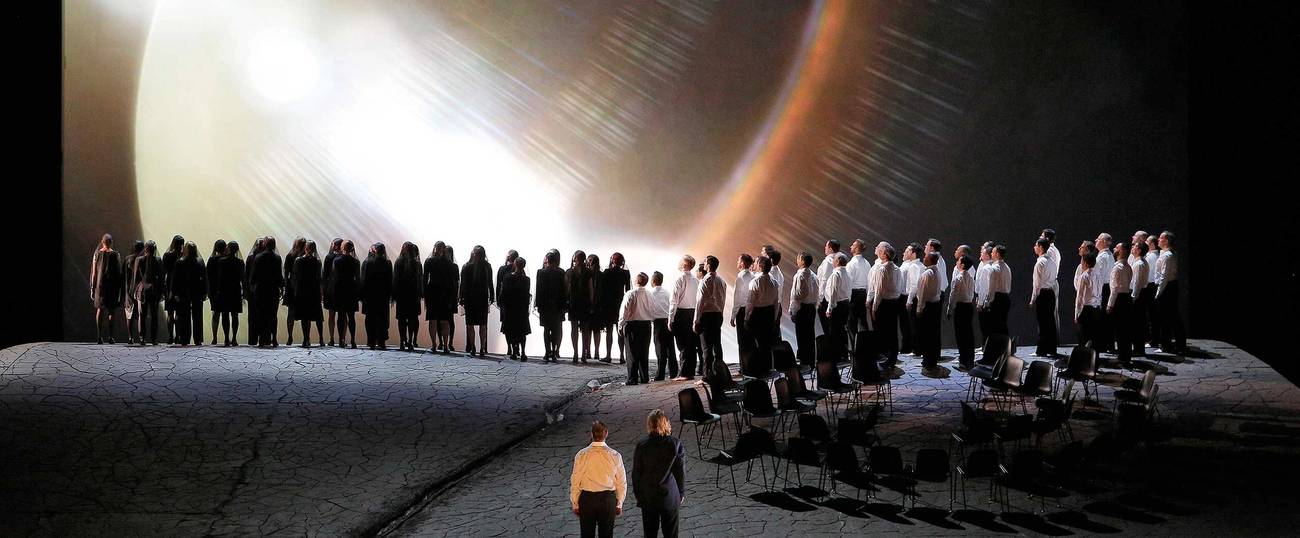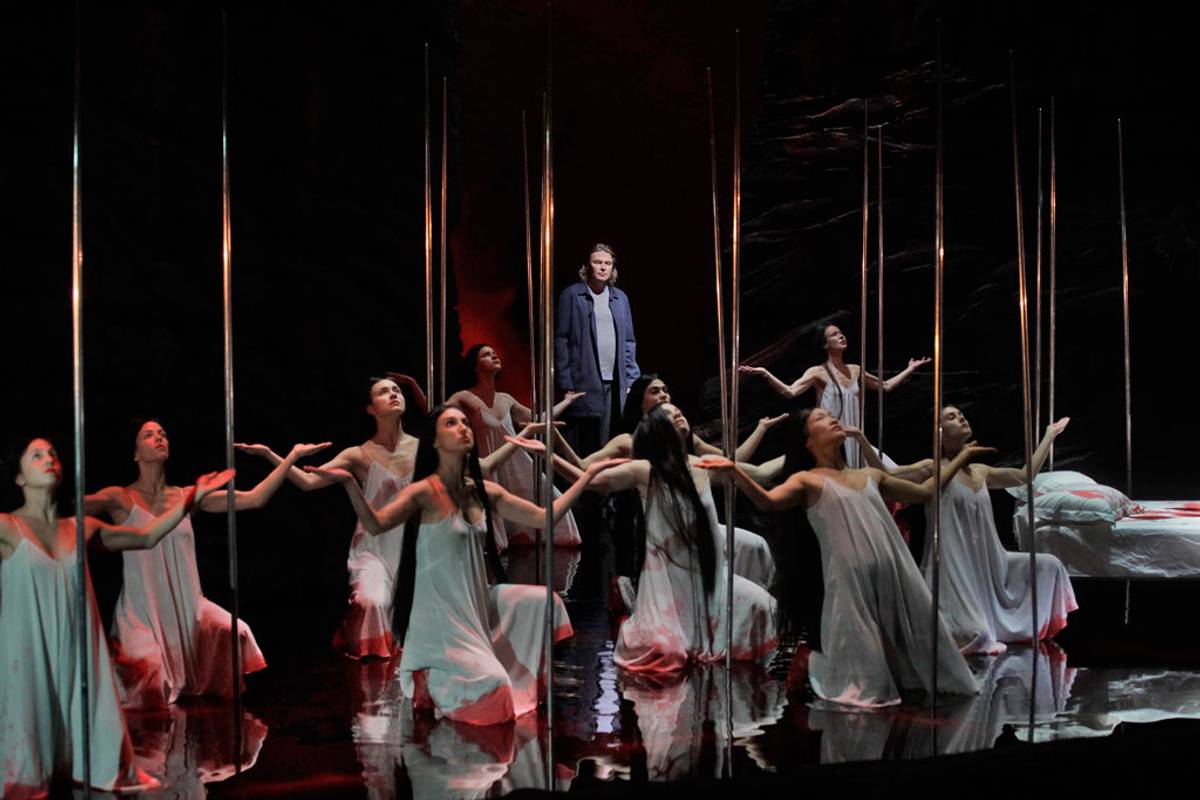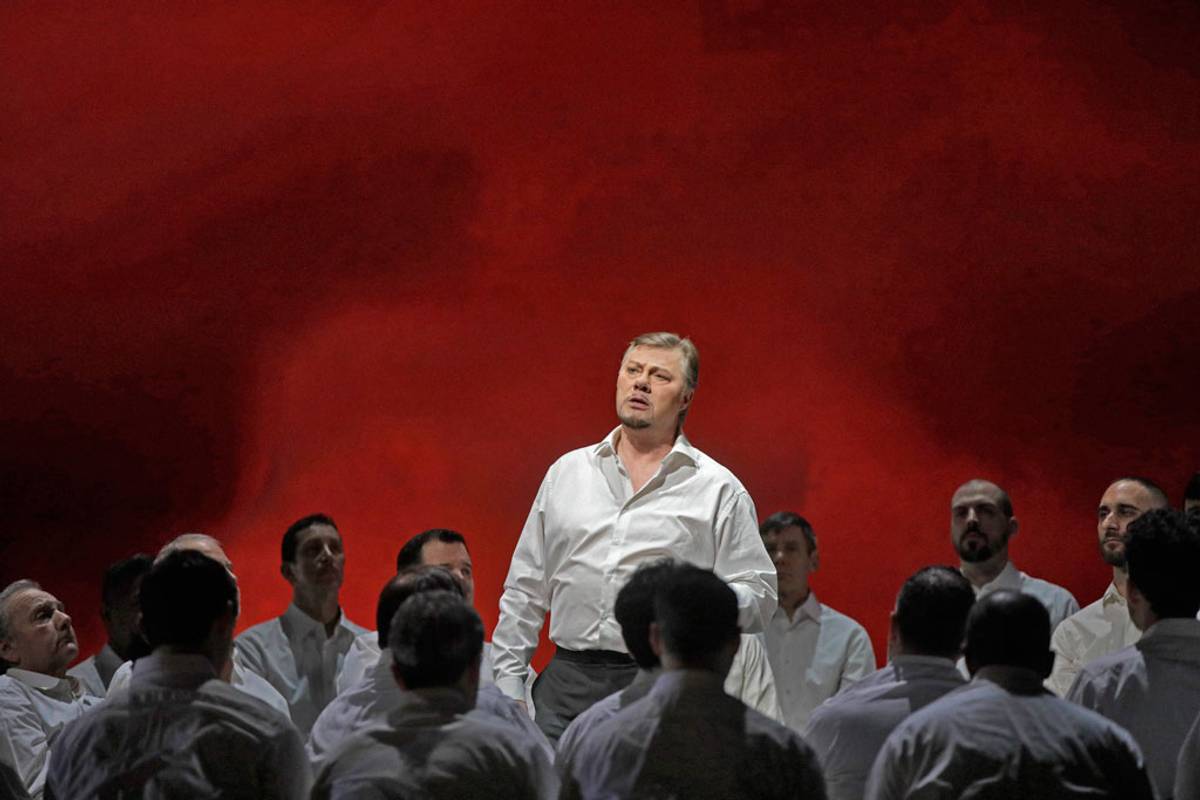A Sea of Blood at the Met
Race theory, Aryan purity, and a Jewish purge in Wagner’s ‘Parsifal’



Wagner’s last opera, Parsifal, returned to the Metropolitan Opera on Feb. 5 under the expert baton of Yannick Nézet-Séguin, who will succeed James Levine as musical director in 2020. Nézet-Séguin led a brilliant cast of singers including the German tenor Klaus Florian Vogt, whose control, power, and musicianship place him in the first rank of Wagner interpreters. François Girard’s 2013 production offers the most striking visual effect I have seen in 50 years of opera-going, a sea of blood on the Met stage during the opera’s second act.
The bloodbath is consistent with the composer’s published understanding of the opera as an allegory about the purification of Aryan blood. This is the sort of Wagner that isn’t usually highlighted in program notes but is amply described in scholarly sources — for example, Joachim Köhler’s excellent Wagner biography. The blood-purification theme is all the more disturbing because it is central to the opera’s message.
Nézet-Séguin’s approach to the score is unconventional but effective. The temple of the Holy Grail “turns time into space,” as one of the characters explains. Conductors in the German tradition, including Levine, use Wagner’s indistinct meter to suggest timelessness. Nézet-Séguin, who studied with the late Carlo Maria Giulini, is more Latin in his approach: He lets us know that the first bars of the prelude are off the beat and makes us aware of the underlying rhythmic pulse. It is brilliant conducting, although Nézet-Séguin sometimes finds a long line where it isn’t there in the first place. James Levine is a hard act to follow, but the 42-year-old Nézet-Séguin is a splendid choice as music director.
Parsifal, after all, is an opera about immortality. The knights of the secret sanctuary of Montsalvat (presumably Montserrat in Catalonia) possess the cup from which Jesus drank at the Last Supper and which collected his blood at the crucifixion. Those who look upon it live indefinitely. The knights are Christians and sing about faith, repentance, salvation, meeting Jesus in Heaven, and so forth, but their greater concern is to prolong their terrestrial life through the magic grail. The trouble is that the wicked magician Klingsor has stolen the knights’ other artifact, the spear that pierced Jesus’s side on the cross and used it to wound King Amfortas, the grail’s guardian. The magic wound won’t heal, and the suffering Amfortas wants to die, which makes him reluctant to display the grail and keep everyone else alive. Parsifal, the innocent fool, takes the spear away from Klingsor and heals Amfortas. This occupies six hours including intervals, even at Nézet-Séguin’s comparatively snappy tempos.
When Wagner completed the work in 1882, the plot did not seem as incongruous as it does to modern audiences. As the great German-Jewish theologian Franz Rosenzweig observed, Christians have always been torn between the promise of eternal bliss and the desire for eternal life in their own skins. The Eucharist is celebrated in the first act of Parsifal, but with a twist. In his 1881 essay “Heroism and Christianity,” Wagner wrote the purpose of the Eucharist—the transformation of wine and bread into the blood and body of Jesus Christ—was to purge Aryan blood of miscegenation with lower races. After the decline of the Aryan race through degradation of its blood, the Eucharist offered an “antidote” to the poison of Jewish blood. Jesus himself was purged of his tainted Jewish blood. That clarifies the final line of the opera’s text, “Redemption to the Redeemer!” Jesus himself must be redeemed; that is, purged of Jewish blood.
***
Wagner adopted the idea of “Aryan Christianity” from Arthur Schopenhauer and wrote the quest for the grail as its symbolic theme in 1849. (This is well documented by Paul Lawrence Rose in his 1992 book Wagner: Race and Revolution.) Wagner had read a modern edition of Wolfram von Eschenbach’s Parzival in 1845 and began to sketch a libretto on the subject in the 1850s. Eschenbach’s epic, based on an earlier French source, belongs to the Arthurian legends: Parsifal is, of course, Sir Percival of the Round Table. Wagner turned a minor character in the Eschenbach into the “arch she-devil” Kundry, a femme-fatale version of the Wandering Jew. She has had many avatars, including the biblical Herodias, who asked for the head of John the Baptist. Kundry laughed at Jesus at the crucifixion and thus is condemned to eternal wandering. Out of repentance, she serves the knights of the grail, but she is also in thrall to the evil Klingsor and seduces grail knights in order to corrupt them. Kundry’s charms helped Klingsor take the spear away from Amfortas. Klingsor also has a troop of enchanted flower maidens ready to lead the grail knights astray. When Parsifal turns up at Klingsor’s magic castle in the second act, he meets the flower maidens, and Kundry appears in her role of arch-seductress. But Parsifal’s sexual desire makes him feel the pain of Amfortas’ terrible wound. He resists Kundry and takes the spear back to the knights at the grail temple. A touch of the spear heals Amfortas’ wound, Kundry is baptized and allowed to die, and Parsifal becomes the new grail king.
Corruption of Aryan blood through Jewish sexuality is central to Wagner’s story, and the Met appropriately presents the whole of act two in a lake of quite realistic but artificial blood. It drenches the white shifts of Kundry and the flower maidens. Theatrical sexuality never has been equated with corruption and death in such a direct way. It is well that we have something to look at because Parsifal’s second act is one of Wagner’s least interesting efforts. The flower maidens sing an exotic little song of seduction that Jules Massenet could have written as well as Wagner, while the horns announce the arrival of Parsifal in a cheery “Here I come to save the day!” motif. One senses that the elderly Wagner, only a year away from death, was exhausted and written out.

Evidently, producer Girard thought that the sex-and-death side of Parsifal would resonate with a contemporary audience. Parsifal, though, belongs to a moment in European history in which Europe had lost its Christian faith but clung to its outer forms. Wagner accordingly wrote a notionally Christian opera about the purification of Aryan blood. This duality is distant from modern audiences, who no longer feel the tension of a Christian heritage jarring with late 19th-century theories of racial supremacy. To make the story seem relevant to globalized cubicle-dwellers, Girard turns the grail temple into something like a corporate offsite. That may, in fact, be the most emotionally intense group experience that the cubicle folk have in the age of Facebook. The grail knights hold stackable chairs over their heads during the prelude. They put the chairs down, remove their jackets, shoes, and socks, and then arrange the chairs in concentric circles. Gurnemanz, the elderly grail knight who fills in the missing bits of the story, appears to be the obligatory motivational speaker. And in the background, abstract shapes gyrate in projection, evoking nothing other than a gigantic screensaver.

When Parsifal returns to the grail temple in act three, the stackable chairs are flung about in disorder, and the screensaver in the background shows something that might be a barren moonscape. This portrays the deterioration of the grail preserve after Amfortas stopped showing the sacred object. Parsifal’s return coincides with Good Friday, and the ten minutes of music describing the revival of nature are the only excerpt of the opera that is performed separately. Incongruously, we still are looking at a moonscape while the singers praise the revival of nature.
The staging of the first and third acts fails as decisively as the second act succeeds. It is all the harder to endure because there is no stage action at all for extended periods, and because Nézet-Séguin demands that we focus our attention on the progress of the music rather than drifting into timelessness as Wagner probably intended. All of this made for an intensely unpleasant experience during the long first act, somewhat tempered by brilliant singing: by Peter Mattei as Amfortas, René Pape as Gurnemanz, and Evelyn Herlitzius as Kundry. Herlitzius has the hardest job in the ensemble because Wagner gave Kundry moans, screeches, and atonal leaps.
It is hard to fault Girard for his failures. A modern audience cannot conceive of the tension between Christianity and the racialist adoration of blood that challenged Christianity and in some cases superseded it. If Wagner’s purpose in writing Parsifal were explained clearly, audiences might not come (although there is always the possibility that the opera might develop a following among white supremacists). As a document in the history of race theory and anti-Semitism, Parsifal has unique importance. It is hard to make sense of the first half of the 20th century without knowing it.
David P. Goldman, Tablet Magazine’s classical music critic, is the Spengler columnist for Asia Times Online, Washington Fellow of the Claremont Institute, and the author of How Civilizations Die (and Why Islam Is Dying, Too) and the new book You Will Be Assimilated: China’s Plan to Sino-Form the World.